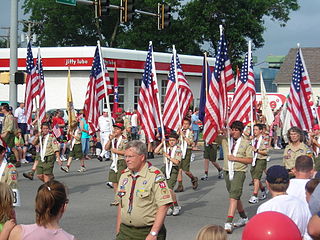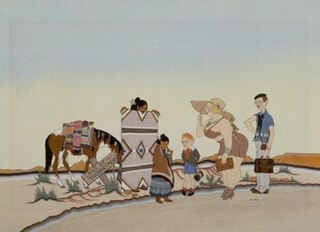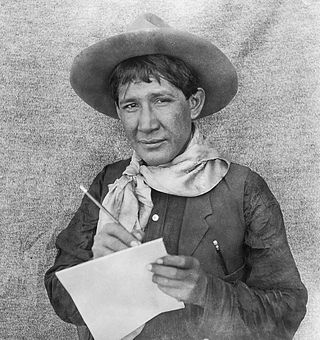Related Research Articles

Scouting in Oklahoma has a long history, from the 1910s to the present day, serving thousands of youth in programs that suit the environment in which they live.

Charles Marion Russell, also known as C. M. Russell, Charlie Russell, and "Kid" Russell, was an American artist of the American Old West. He created more than 2,000 paintings of cowboys, Native Americans, and landscapes set in the western United States and in Alberta, Canada, in addition to bronze sculptures. He is known as "the cowboy artist" and was also a storyteller and author. He became an advocate for Native Americans in the west, supporting the bid by landless Chippewa to have a reservation established for them in Montana. In 1916, Congress passed legislation to create the Rocky Boy Reservation.

Thomas Moran was an American painter and printmaker of the Hudson River School in New York whose work often featured the Rocky Mountains. Moran and his family, wife Mary Nimmo Moran and daughter Ruth, took residence in New York where he obtained work as an artist. He was a younger brother of the noted marine artist Edward Moran, with whom he shared a studio. A talented illustrator and exquisite colorist, Thomas Moran was hired as an illustrator at Scribner's Monthly. During the late 1860s, he was appointed the chief illustrator for the magazine, a position that helped him launch his career as one of the premier painters of the American landscape, in particular, the American West.

Frederic Sackrider Remington was an American painter, illustrator, sculptor, and writer who specialized in the genre of Western American Art. His works are known for depicting the Western United States in the last quarter of the 19th century and featuring such images as cowboys, American Indians, and the US Cavalry.

Fernando Amorsolo y Cueto was a portraitist and painter of rural Philippine landscapes. Nicknamed the "Grand Old Man of Philippine Art," he was the first-ever to be recognized as a National Artist of the Philippines. He was recognized as such for his "pioneering use of impressionistic technique" as well as his skill in the use of lighting and backlighting in his paintings, "significant not only in the development of Philippine art but also in the formation of Filipino notions of self and identity."

Woodrow Wilson Crumbo (1912—1989) was a Native American artist and educator from Oklahoma. He was a citizen of the Citizen Potawatomi Nation. Traveling and performing extensively, he danced and played Native American flute.
Albert Lee Harjo, born in the Muscogee (Creek) Nation in Hanna, Oklahoma, was a fullblood Muscogee artist.

Charles Banks Wilson was an American artist. Wilson was born in Springdale, Arkansas in 1918; his family eventually moved to Miami, Oklahoma, where he spent his childhood. A painter, printmaker, teacher, lecturer, historian, magazine and book illustrator, Wilson's work has been shown in over 200 exhibitions in the United States and across the globe.
The Bacone school or Bacone style of painting, drawing, and printmaking is a Native American intertribal "Flatstyle" art movement, primarily from the mid-20th century in Eastern Oklahoma and named for Bacone College. This art movement bridges historical, tribally-specific pictorial painting and carving practices towards an intertribal Modernist style of easel painting. This style is also influenced by the art programs of Chilocco Indian School, north of Ponca City, Oklahoma, and Haskell Indian Industrial Training Institute, in Lawrence, Kansas and features a mix of Southeastern, Prairie, and Central Plains tribes.

Earnest Spybuck was an Absentee Shawnee Native American artist, who was born on the land allotted the Shawnee Indians in Indian Territory and what was to later become Pottawatomie County, Oklahoma, near the town of Tecumseh. M. R. Harrington, an archaeologist/anthropologist, was touring the area documenting Native Americans, their history, culture and living habits. Interested in the religious ceremonies of the Shawnee which included the use of peyote, Harrington had ventured to the Shawnee Tribal lands. There he learned of Earnest Spybuck's artistic work and encouraged Spybuck in his endeavors. While Spybuck's work was obviously art, Harrington saw that he was illustrating detailed scenes of ceremonies, games, and social gatherings which could be used to illustrate many anthropological publications. Spybuck's work was received positively by both Native American and non-native artistic communities. Many of his works are now held by the Smithsonian's National Museum of the American Indian.

The Pawnee Bill Ranch, also known as the Blue Hawk Peak Ranch, was the home of Wild West show entertainer, Gordon W. "Pawnee Bill" Lillie. Located in Pawnee, Oklahoma, it is owned and operated by the Oklahoma Historical Society. The Pawnee Bill Ranch consists of 500 of the original 2000 acres, original outbuildings, a fully furnished historic home, a modern museum, and a herd of bison, Longhorn cattle, and horses.
Bunky Echo–Hawk is a Native American artist and poet who is best known for his acrylic paintings concerning Native American topics and hip-hop culture. He works in a variety of media that include paintings, graphic design, photography, and writing.

David John Mosher Wood was an American Indian agent and Methodist minister.
Wendy Ponca is an Osage artist, educator, and fashion designer noted for her Native American fashion creations. From 1982 to 1993, she taught design and Fiber Arts courses at the Institute of American Indian Arts (IAIA) of Santa Fe and later taught at the University of Las Vegas. She won first place awards for her contemporary Native American fashion from the Santa Fe Indian Market each year between 1982 and 1987. Her artwork is on display at IAIA, the Los Angeles County Museum of Art, the Philbrook Museum of Art and the Smithsonian Institution's National Museum of the American Indian.

Yatika Starr Fields is a Native American painter, muralist and street artist, born in the city of Tulsa, Oklahoma. His artworks were shown at numerous galleries and museums, including the APEC Young Artist Exhibition and recently in the Sam Noble Museum.

Solomon McCombs was a Native American artist from Oklahoma known for his paintings, murals, and illustrations.

Ty Burns is an American politician, educator, former law enforcement officer, and retired United States Army infantryman serving as a member of the Oklahoma House of Representatives from the 35th district. Elected in November 2018, he assumed office on November 21, 2018.
Benjamin Arkeketa, also called Thinga-Ja-Bus-Ka, was an American painter from the Oto-Missouria Tribe. He was a member of the "Che" Buffalo Clan, and his paternal great-great-grandfather was Chief George Arkeketa. Influenced by Brummett Echohawk and Acee Blue Eagle, Arkeketa was known for his paintings related to his tribal archaeology and ethnology as well as Christian philosophy.
Samuel Seymour was a painter, engraver, and illustrator who documented Native American people and the scenery from expeditions of Stephen Harriman Long in 1819, 1820, and 1823. Some of the drawings captured new species of flora and fauna.

Woodrow Wilson "Woody" Big Bow, was a Kiowa painter, contractor and builder. He painted in the flat style, often depicting Kiowa people and Indigenous life as well as natural scenery. Big Bow exhibited his artwork across the United States and Europe and has worked in the public collections of several institutions including the Gilcrease Museum, the Philbrook Museum of Art, the Wichita Art Museum, and the Smithsonian National Museum of the American Indian.
References
- 1 2 3 4 5 Youngbull, Kristin M. (2012). Brummett Echohawk: chaticks-si-chaticks (Report). Arizona State University.
- 1 2 “Recollections of the Pawnee Scouts.” Western Horseman Magazine 38, 1 January 1973 Pages: 26-28, 133-135.
- ↑ "Brummett Echohawk, An Island of Redbuds on the Cimarron (video)". Khan Academy. Retrieved 2024-04-08.
- ↑ Joseph Wydeven and Clem Klaphake, “Art and Eloquence,” Nebraskaland 62, 1 January-February 1984. 104-106
- ↑ Echohawk,Brummett. "Massacre Canyon on Canvas." The Western Horseman Magazine. July 1983. 48.7 Pages: 20-23.
- 1 2 "Echohawk's Warrior Paintings | Edmond Outlook". 2023-09-01. Retrieved 2024-04-08.